(Mise à jour pour être en accord avec la nouvelle version de la source de la page) |
|||
| Ligne 20 : | Ligne 20 : | ||
In biopony, the nutrient solution is not sterile and bacteria, micro-organisms and fungi can develop. These active micro-organisms will make it possible to transform certain substances such as ammonia into nitrate, one of the nutrients essential for plant growth. In our case we use an organic solution by mixing water with human urine (1% urine in relation to the volume of water). | In biopony, the nutrient solution is not sterile and bacteria, micro-organisms and fungi can develop. These active micro-organisms will make it possible to transform certain substances such as ammonia into nitrate, one of the nutrients essential for plant growth. In our case we use an organic solution by mixing water with human urine (1% urine in relation to the volume of water). | ||
| − | |||
"Hydroponics has many advantages in certain contexts: | "Hydroponics has many advantages in certain contexts: | ||
* In arid regions where fertile land and water are scarce. Hydroponics can save 7 to 10 times the volume of water needed for irrigation compared to conventional agriculture. It also helps to avoid water stress. | * In arid regions where fertile land and water are scarce. Hydroponics can save 7 to 10 times the volume of water needed for irrigation compared to conventional agriculture. It also helps to avoid water stress. | ||
| Ligne 26 : | Ligne 25 : | ||
* In case of soil pollution. | * In case of soil pollution. | ||
* Allows better control of invasive insects. | * Allows better control of invasive insects. | ||
| − | |||
| − | |||
| − | |||
*Dans les régions arides où les terres fertiles et l'eau se font rares. '''L'hydroponie permet de faire économiser de 7 à 10 fois les volumes d'eau''' nécessaires à l'irrigation en comparaison avec l'agriculture conventionnelle. Elle permet également d'éviter les stress hydriques. | *Dans les régions arides où les terres fertiles et l'eau se font rares. '''L'hydroponie permet de faire économiser de 7 à 10 fois les volumes d'eau''' nécessaires à l'irrigation en comparaison avec l'agriculture conventionnelle. Elle permet également d'éviter les stress hydriques. | ||
| Ligne 252 : | Ligne 248 : | ||
Arduino control system: | Arduino control system: | ||
</div> | </div> | ||
| + | |||
| + | [[Gestion énergétique d'un système d'hydroponie/fr]] | ||
| + | |||
| + | <br /> | ||
}} | }} | ||
{{ {{tntn|Tuto Step}} | {{ {{tntn|Tuto Step}} | ||
| Ligne 283 : | Ligne 283 : | ||
}} | }} | ||
{{ {{tntn|Notes}} | {{ {{tntn|Notes}} | ||
| − | |Notes= | + | |Notes=Système de commande Arduino: [[Gestion énergétique d'un système d'hydroponie/fr]] |
}} | }} | ||
{{ {{tntn|Tuto Status}} | {{ {{tntn|Tuto Status}} | ||
Version du 3 septembre 2019 à 11:41
Description
This tutorial aims to introduce hydroponics and how to build an individual system. This technology was documented during a stopover in Singapore of the "Nomade des Mers" expedition. We met Comcrop, a company that grows aromatic plants (basil, mint...) on an area that is usually unused and worthless: the roofs of buildings!
Sommaire
Sommaire
[masquer]
Introduction
Hydroponics is the cultivation of plants and vegetation above ground and in water. The roots are immersed in a neutral and inert substrate (such as clay balls, sand...) which serves as a support. They directly capture the nutrients necessary for their growth in water enriched with a nutrient solution. Unlike conventional hydroponics, bioponics (hydroponics+organic) allows fruits and vegetables to be grown organically without the use of synthetic chemical fertilizers. These are replaced by organic fertilizers such as manure, earthworm, urine or compost juice.
In biopony, the nutrient solution is not sterile and bacteria, micro-organisms and fungi can develop. These active micro-organisms will make it possible to transform certain substances such as ammonia into nitrate, one of the nutrients essential for plant growth. In our case we use an organic solution by mixing water with human urine (1% urine in relation to the volume of water).
"Hydroponics has many advantages in certain contexts:
- In arid regions where fertile land and water are scarce. Hydroponics can save 7 to 10 times the volume of water needed for irrigation compared to conventional agriculture. It also helps to avoid water stress.
- In cities and urban areas where there is little space available for earth cultivation. It is particularly suitable for cultivation in restricted spaces (roofs of buildings, apartments, abandoned factories, etc.). As it can be developed vertically, hydroponics also makes it possible to obtain a production per square meter much higher than land agriculture. It can also allow a return to culture among urban residents, who are often disconnected from nature.
- In case of soil pollution.
- Allows better control of invasive insects.
- Dans les régions arides où les terres fertiles et l'eau se font rares. L'hydroponie permet de faire économiser de 7 à 10 fois les volumes d'eau nécessaires à l'irrigation en comparaison avec l'agriculture conventionnelle. Elle permet également d'éviter les stress hydriques.
- Dans les villes et zones urbaines où peu d'espaces sont disponibles à la culture en terre. Elle convient particulièrement à la culture dans des espaces restreints (toits d'immeubles, appartements, usine désaffectée...). Pouvant être développée de manière verticale, l'hydroponie permet également d'obtenir une production au mètre carré bien supérieure à l'agriculture en terre. Elle peut également permettre un retour à la culture chez les citadins, souvent déconnectés de la nature.
- En cas de pollution des sols.
- Permet de mieux contrôler les insectes invasifs.
"But hydroponics can also have disadvantages:
- Can be expensive and uneconomical if installed in greenhouses with artificial lighting and heating.
- In a non-organic hydroponic system, the nutrient solution must be renewed regularly. Water rich in minerals and oligo-elements is then rejected and can affect the ecosystem. In this tutorial, we present a method to avoid chemical inputs.
- The environment being humid and hot, bacteria or diseases can spread very quickly. Hydroponics requires particular and daily attention to the health of plants.
- Peut s'avérer coûteuse et peu écologique si elle est mise en place sous serre avec éclairage artificiel et chauffage.
- Dans un système d'hydroponie non biologique, la solution nutritive doit être renouvelée régulièrement. De l'eau riche en minéraux et oligo-éléments est alors rejetée et peut affecter l'écosystème. Dans ce tutoriel, nous présentons une méthode permettant d'éviter les intrants chimiques.
- Le milieu étant humide et chaud, les bactéries ou maladies peuvent se propager très rapidement. L'hydroponie demande une attention particulière et quotidienne à la bonne santé des plantes.
Youtube
Matériaux
1. Crop gutters ((* Cleats (minimum width 10cm))
- Plastic sheeting
- Staples
- Clay beads
- Brackets
- Wood screws
- Young shoots and cuttings
2. Irrigation system
- 1 Submersible pump (aquarium pump)
- 5 m of thin plastic pipe (pump outlet)
- 1 End cap with 4 outlets for fine pipe
- 50 cm of wide plastic tube (Link between the filter and the bio-filter)
- 1 Wide pipe end cap (to be fixed on the filter tank)
- 1 Blower
3. Filter and bio-filter
- 2 plastic bins of 60L
- Large gravel
- Sand
- 10L Clay beads
- 40L of water
Modèle:In order to ensure homogeneity of the water in terms of nutrients and temperature, we recommend using about 40L of water per square metre of cultivation. 4. Control system
- Socket outlet with programmable timer or Arduino
- Tasseaux (10cm de largeur minimum)
- Bâche plastique
- Agrafes
- Billes d'argiles
- Équerres
- Vis à bois
- Jeunes pousses et boutures
2. Système d'irrigation
- 1 Pompe immergée (pompe d'aquarium)
- 5 m de tuyau plastique fin (Sortie pompe)
- 1 Embout avec 4 sorties pour tuyau fin
- 50 cm de tuyau plastique large (Lien entre le filtre et le bio-filtre)
- 1 Embout de tuyau large (à fixer sur le bac du filtre)
- 1 Bulleur
3. Filtre et bio-filtre
- 2 Bacs en plastique de 60L
- Gros gravier
- Sable
- 10L Billes d'argile
- 40L d'eau
4. Système de commande
- Prise de courant avec minuterie programmable ou Arduino
Outils
- Drill/driver or screwdriver
- Saw
- Stapler
- Hole saw
- Cutter or scissors
Étape 1 - Manufacture of culture gutters
The system used measures 2m long by 50cm wide. The skeleton is made up of 4 cleats / bamboos fixed in parallel at a distance of 15 cm thanks to wooden cleats. It is covered with an agricultural cover (width 1m) so as to form 3 gutters about 10cm deep. These gutters are filled with clay balls. An aquarium pump immersed in the biofilter tank propels the nutrient solution from the top side of these gutters (inclination of about 10 degrees) so that it flows through the clay balls until it returns to the storage tank (biofilter). The table is about 1.2m high (ergonomic for taking care of plants). A shade screen is attached like a skirt on the sides to protect the biofilters, nutrient solution storage tank and mushroom farm from the sun.
- Manufacturing of the support
- In this model we explain the process for 3 gutters but it is of course possible to duplicate it at will !
- Cut 4 strips of the same length (190 cm for us)
- Attach them parallel to a support using brackets and screws at regular intervals (15 cm)
- Staple the tarpaulin on the side of the first strip and then extend it to cover the next three (Possibility to double the tarpaulin for more resistance)
- Form gutters with the tarpaulin until it touches the support
- Staple the tarpaulin on each strip and cut it out.
- Water recovery
- Fabrication du support
- Dans ce modèle nous expliquons le procédé pour 3 gouttières mais il est bien-sûr possible de le dupliquer à volonté !
- Découper 4 tasseaux de mêmes longueurs (190 cm pour nous)
- Les fixer parallèlement sur un support grâce aux équerres et aux vis à intervalle régulier (15 cm)
- Agrafer la bâche sur le côté du premier tasseau puis l'étendre pour recouvrir les 3 suivants (Possibilité de doubler la bâche pour plus de résistance)
- Former des gouttières avec la bâche jusqu'à ce qu'elle touche le support
- Agrafer la bâche sur chaque tasseau puis découper là.
- Récupération de l'eau
2. Water recovery
The water system operates in a closed circuit. The water is pumped into the biofilter that serves as a reservoir, exits at one end of the gutter and is recollected at the other end before passing through a filter and returning to the initial reservoir.
In order to recover the water, the tarpaulin is pierced very finely (to prevent the clay balls from escaping) at the opposite end of the water inlet. Below this end, another tarpaulin is stapled to form a pocket to collect and channel the water before it flows into the filter.
Étape 2 - Filter and Biofilter
Once passed through the plants, the water flows into two separate tanks: the filter and the biofilter.
- The purpose of the filter is to block all coarse particles that could block the pumps (root and leaf residues, erosion of clay balls, etc.). The filter has three stages of filtration, from the finest to the coarsest.
- The biofilter constitutes the water reservoir, to which is added about a quarter of the volume in clay beads. These serve as a culture medium for bacteria that will allow the transformation of natural inputs (urine, compost juice, etc.) into nutrients that can be assimilated by plants. In particular, the transformation of ammonia into nitrite and then nitrate, essential for foliar development (leaf development). Bacteria develop naturally after 6 weeks or can be purchased in culture at hydroponics sites.
For their proper development, bacteria need:
- of moisture, provided by water
- shadow
- of oxygen, install a bubbler to regularly stir the water in the biofilter.
- of food, natural inputs
For our part, we only use human urine as an input (See below for assays)!
- d'humidité, apportée par l'eau
- d'ombre
- d’oxygène, installer un bulleur afin de remuer régulièrement l'eau du biofiltre.
- de nourriture, les intrants naturels
Pour notre part, nous utilisons uniquement de l'urine humaine comme intrant (Voir plus bas pour les dosages) !
- Filter
- At the bottom of the first tank, drill a hole with the hole saw of the diameter of your outlet pipe to the second tank.
- Install the nozzle and hose on the tank
- Spread a layer of coarse gravel on the bottom (1/4 of the filter volume)
- Add a layer of clay beads of the same thickness
- Add a slightly thinner layer of sand on top
- Install the filter under the water pocket at the outlet of the gutter, and raise it above the biofilter to allow the water to flow by gravity.
- Filtre
- En bas du premier bac, percer un trou avec la scie cloche du diamètre de votre tuyau de sortie vers le deuxième bac.
- Installer l'embout et le tuyau sur le bac
- Étaler une couche de gravier assez gros au fond (1/4 du volume du filtre)
- Ajouter une couche de billes d'argile de la même épaisseur
- Ajouter une couche de sable un peu plus fine au dessus
- Installer le filtre sous la poche d'eau en sortie de la gouttière, et le surélever par rapport au biofiltre pour permettre à l'eau de s'écouler par gravité.
2. Biofilter
- Fill the second tank with water (40L) and add about a quarter of the volume of water in clay balls (10L)
- Remplir le second bac d'eau (40L) et ajouter environ un quart du volume d'eau en billes d'argiles (10L)
In our system, the clay beads of the biofilter are replaced by plastic beads that are also good nests for bacteria (but not natural).
Étape 3 - Irrigation system and bubbler
After being filtered, oxygenated and recharged with nutrients, the water is ready to be re-injected into the system. For this purpose, a small submersible pump is used. The power of the pump depends on the size of your system.
- Measure a length of plastic pipe (of a diameter suitable for your pump) from the biofilter to the end of the gutters.
- Connect one end to the pump and the other to a 4-way nozzle (to be adapted according to the number of gutters), placed at the end of the gutters
- Attach this end cap to the central gutter.
- Connect pipes to the outlets of the nozzle to irrigate all gutters.
- Immerse the pump in the biofilter
- Immerse the bubbler in the biofilter
- Mesurer une longueur de tuyau en plastique (d'un diamètre adapté à votre pompe) allant du biofiltre à l'extrémité des gouttières.
- Connecter une extrémité à la pompe et l'autre, à un embout à 4 sorties (à adapter en fonction du nombre de gouttières), placé à l’extrémité des gouttières
- Fixer cet embout au niveau de la gouttière centrale.
- Connecter des tuyaux aux sorties de l'embout afin d'irriguer toutes les gouttières.
- Plonger la pompe dans le biofiltre
- Plonger le bulleur dans le biofiltre
Étape 4 - Control system
In order to gain in autonomy, it is possible to install a timer system thanks to a programmable electrical socket or an arduino allowing to program the starting of the pump and the bubbler.
- Indeed, for a better development of the plants, it is advisable to proceed to a regular watering alternated with dry breaks. This water stress will strengthen the roots.
For this purpose, we recommend that the pump be switched on for 30 minutes every 2 hours during the day. No watering at night.
- The biofilter needs to be aerated regularly for good growth and survival of bacteria.
"We recommend lighting the bubbler for 1 minute every 5 minutes, 24 hours a day.
- En effet, pour un meilleur développement des plantes, il est conseillé de procéder à un arrosage régulier alterné avec des temps de pauses sèches. Ce stress hydrique permettra un renforcement des racines.
Pour cela, nous conseillons un allumage de la pompe pendant 30 min toutes les 2h, durant la journée. Pas d'arrosage la nuit.
- Le biofiltre a besoin d'être aéré régulièrement pour une bonne croissance et la survie des bactéries.
Nous conseillons un allumage du bulleur 1 minute toutes les 5 minutes, 24h/24.
Arduino control system:
Gestion énergétique d'un système d'hydroponie/fr
Étape 5 - Crop selection and harvesting
Not all crops are suitable for hydroponics. It is easier, especially without chemical fertilizers, to prefer leafy vegetables (lettuce, cabbage, spinach, sweet potatoes...) and herbs (mint, basil, coriander).
"Plant" them in the clay balls, making sure that the roots are well immersed.
"It is always necessary to integrate the plants after sowing or cutting them so that they have developed a long and strong root system. "
Some advice:
- Prefer direct light if possible but do not hesitate to add shade in case of high heat.
- Ventilate the system well and control the temperature. Do not hesitate to add a small fan in case of high heat.
- Regularly check that the roots are under the clay balls.
- Check the colour of the leaves regularly: if they turn yellow, this may be due to excessive watering, lack of nutrients, poor pH or too much sunlight.
- Préférer la lumière directe si possible mais ne pas hésiter à ajouter de l'ombrage en cas de grosses chaleurs
- Bien aérer le système et contrôler la température. Ne pas hésiter à ajouter un petit ventilateur en cas de grosses chaleurs.
- Vérifier régulièrement que les racines soient sous les billes d'argiles.
- Vérifier régulièrement la couleur des feuilles: si celles-ci jaunissent, cela peut être dû à un arrosage excessif, un manque de nutriments, un mauvais pH ou un trop fort ensoleillement.
- Transplant the shoots at the end of the day.
- Transplant the shoots when they have at least 5 leaves. Then you have to water.
- Cuttings: for mint and sweet potatoes, for example, cut one or more branches. Remove the leaves on about 2/3 of the branch. Bury this cleared area under the clay balls. Then you have to water.
- Harvest in the morning, shortly after sunrise. Choose the oldest, most damaged leaves or leaves that develop in parallel with auxiliary shoots.
Notes et références
Système de commande Arduino: Gestion énergétique d'un système d'hydroponie/fr
Published
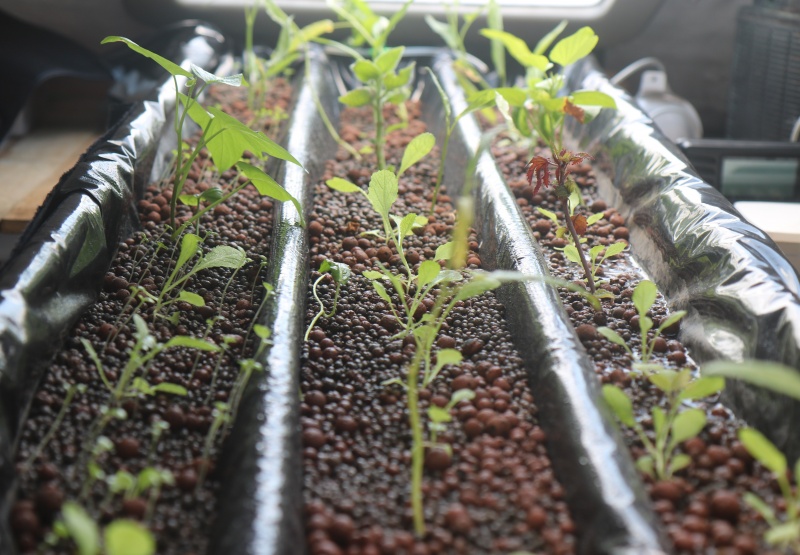
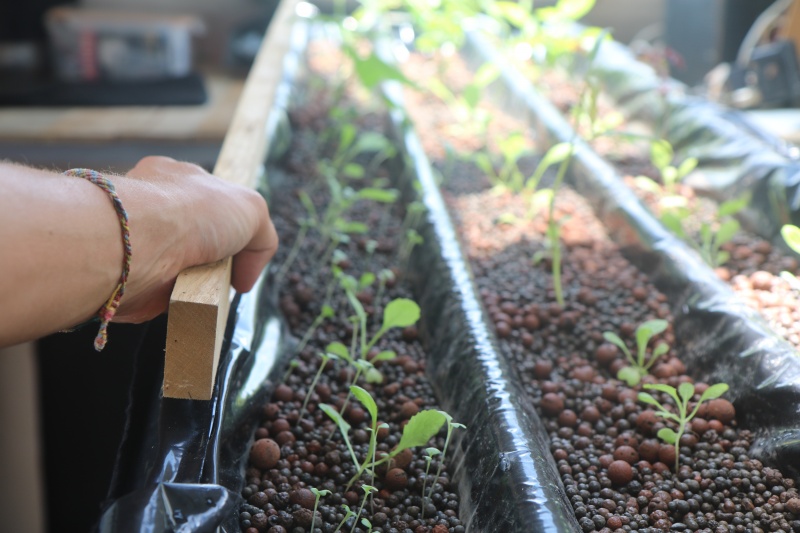
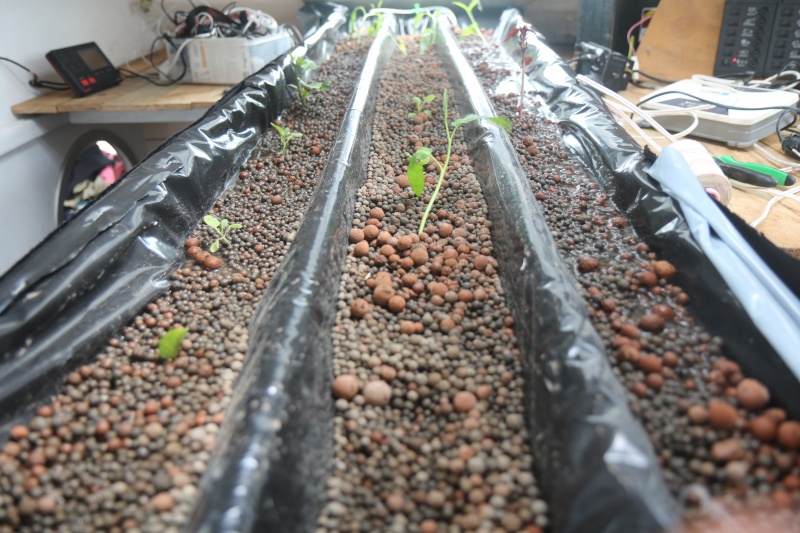
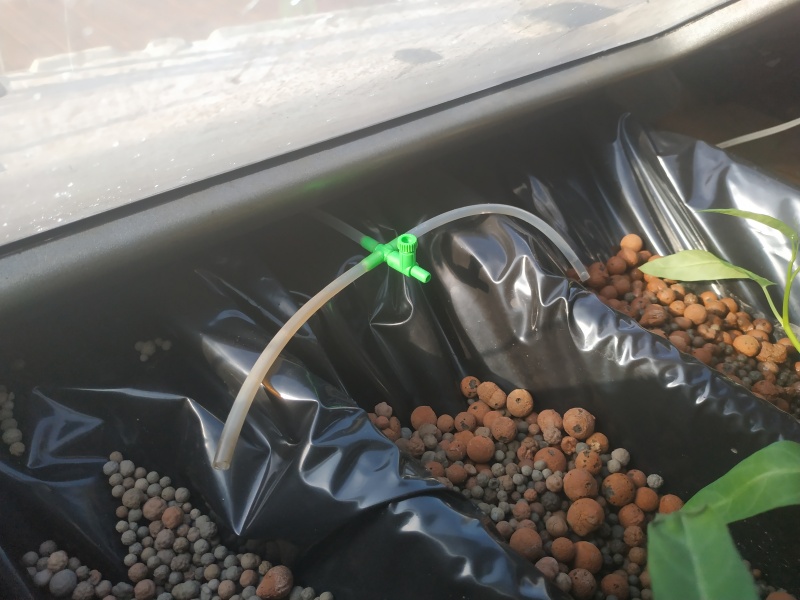
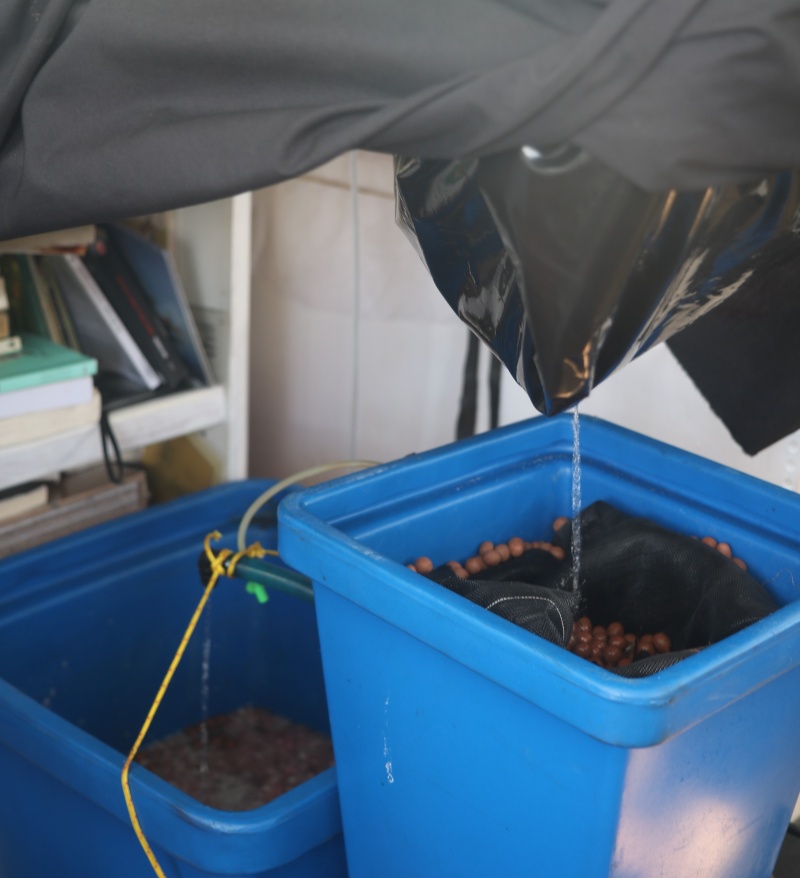
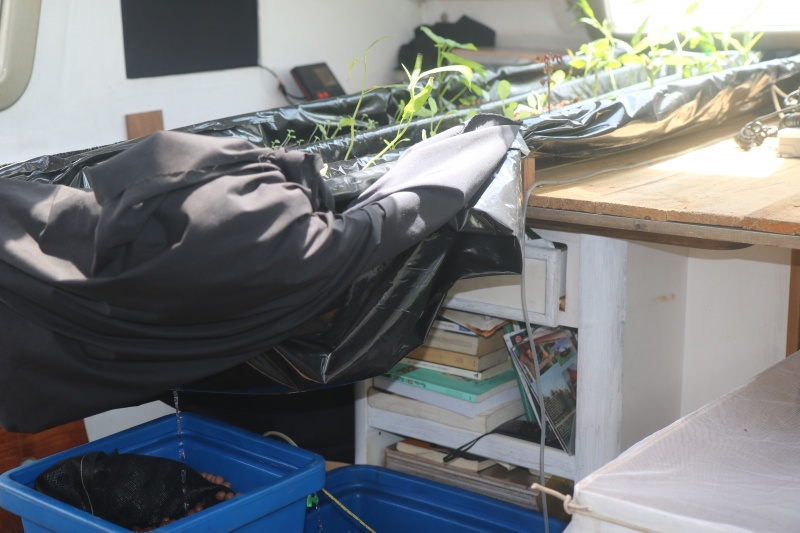
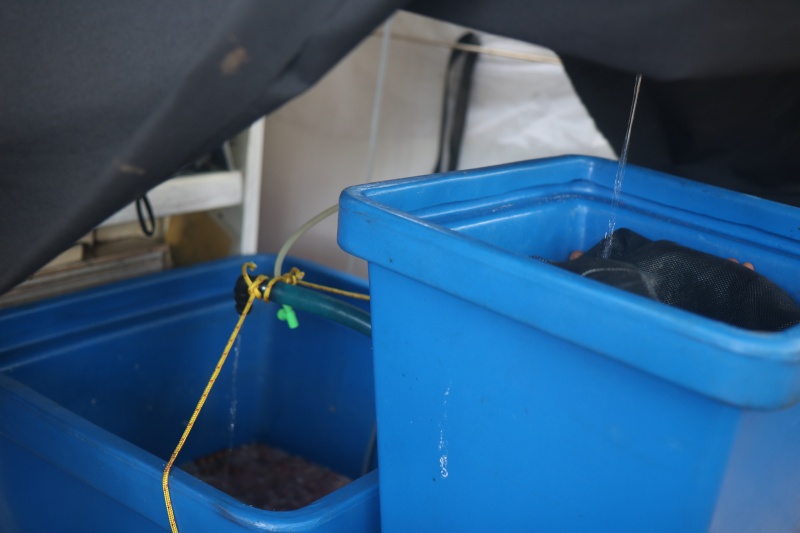
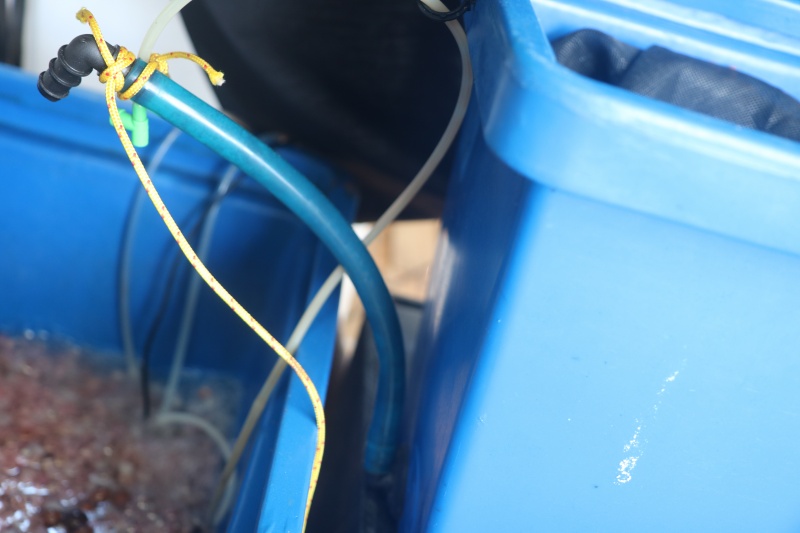
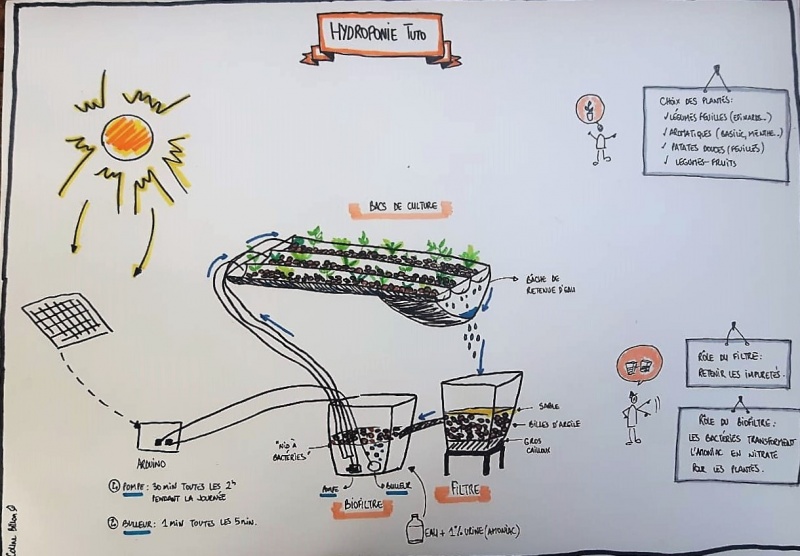
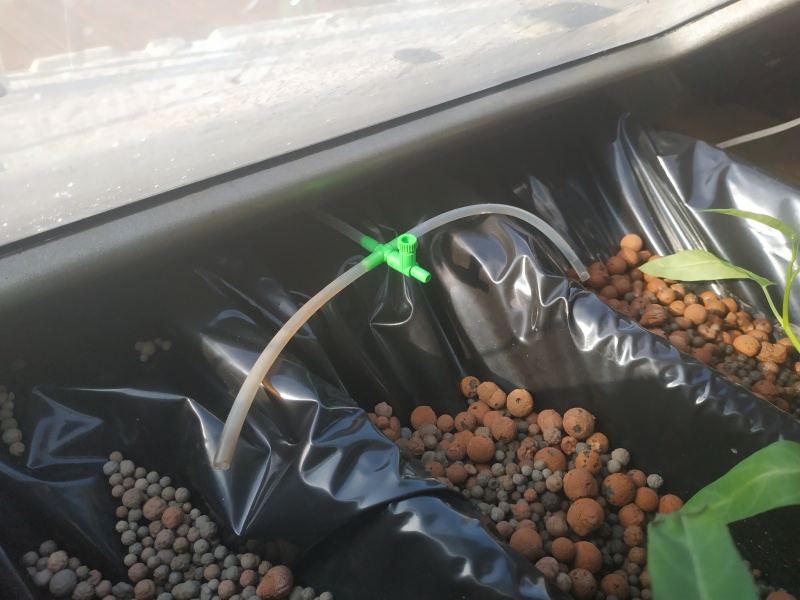
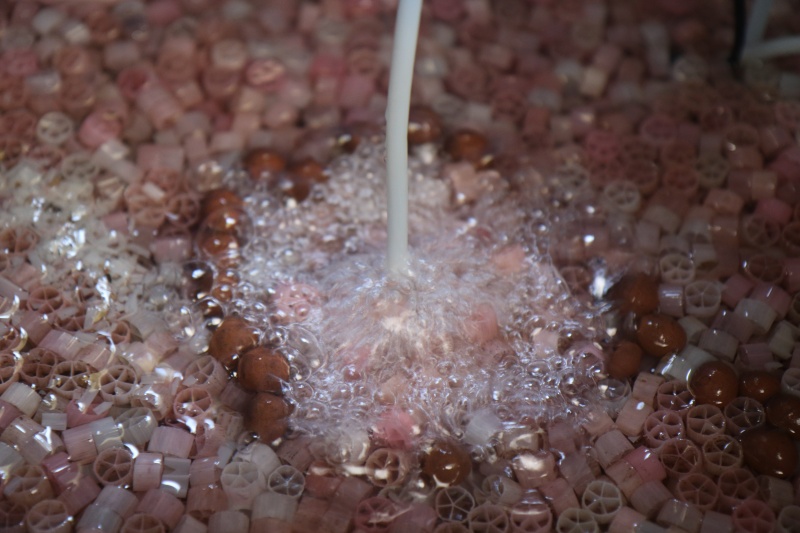
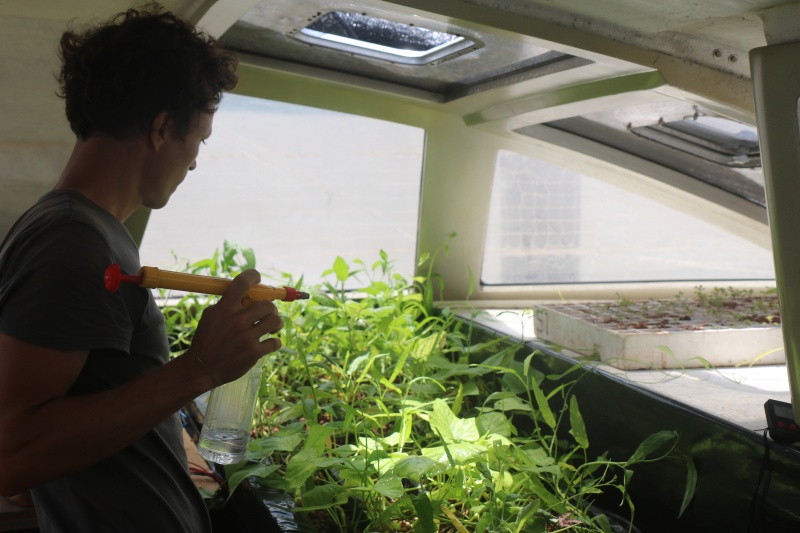
 Français
Français English
English Deutsch
Deutsch Español
Español Italiano
Italiano Português
Português
Bonjour, ce tuto est super mais pour une utilisation sans utiliser d'urine on peut penser à l'aquaponie !